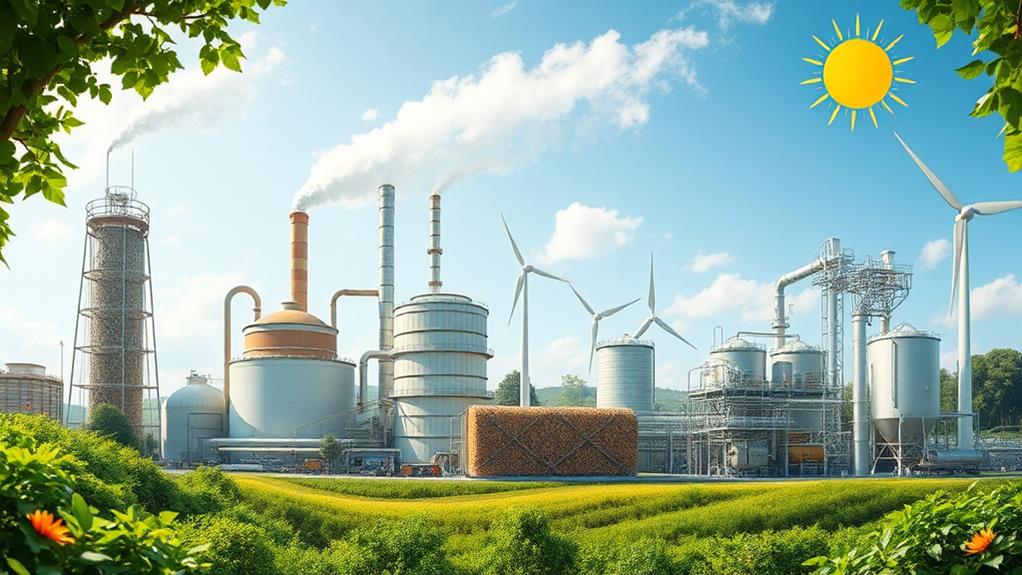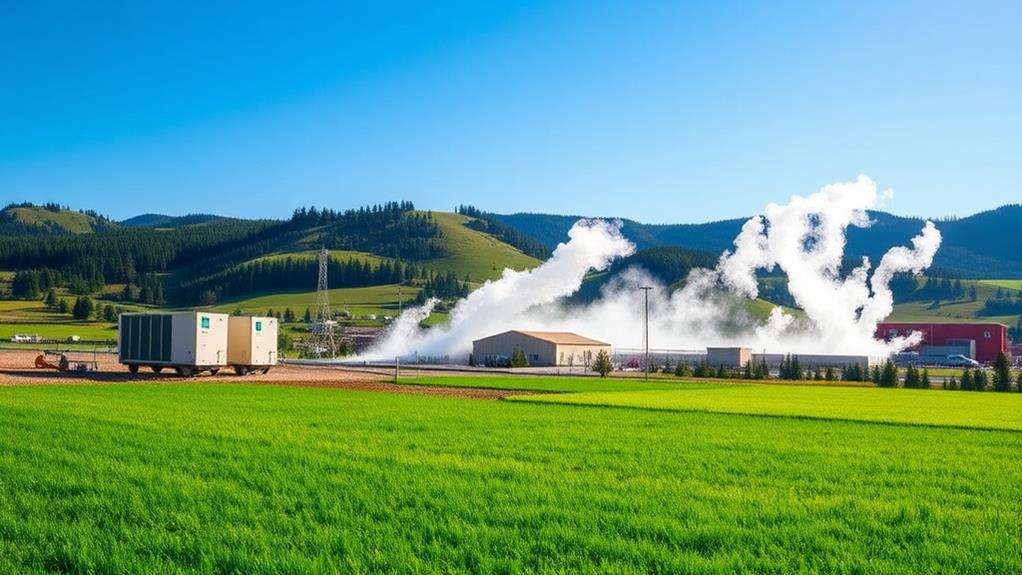In biomass energy production, there are five key factors that greatly influence costs: feedstock availability and pricing, transportation expenses, processing technologies, regulatory frameworks, and the scale of production. Feedstock prices vary between €25 and €43 per ton, and transportation can account for 15% to 30% of production budgets. Processing methods, such as direct combustion and gasification, enhance efficiency, while regulatory compliance is essential for operational sustainability. Additionally, larger systems benefit from economies of scale, reducing capital costs from $3,000 to $5,000 per kW. Understanding these aspects is crucial for effective cost management, offering further insights into sustainability strategies.
Key Takeaways
- Feedstock Pricing: Biomass feedstock costs range from €25 to €43 per ton, influenced by seasonal variations and market demand.
- Transportation Expenses: Transportation accounts for 15% to 30% of production costs, affected by distance, diesel prices, and biomass moisture content.
- Processing Technologies: Conversion methods like direct combustion, gasification, and pyrolysis vary in efficiency and cost, influenced by feedstock moisture content.
- Regulatory Compliance: Air quality permits and emission standards necessitate additional costs and management efforts for biomass operations.
- Scale of Production: Larger biomass systems benefit from economies of scale, reducing capital costs and overall production expenses compared to smaller plants.
Feedstock Availability and Pricing
When it comes to biomass energy production, understanding feedstock availability and pricing is essential for our economic viability. The market price for biomass feedstock can vary between €25 and €43 per ton, influenced by competition with conventional crops for land use. Our focus should be on local biomass resources, as about 70% of European biomethane is derived from energy crops, making efficient land allocation crucial. Seasonal variations and market demand greatly impact feedstock pricing, directly affecting our production costs. Utilizing geographic information systems (GIS) allows us to assess biomass availability, optimizing our feedstock sourcing based on local soil, climate, and agricultural practices. As a result, keeping a close eye on these factors will enhance our strategic planning and operational efficiency.
Transportation Expenses

Considering the significant role transportation costs play in biomass energy production, we find that these expenses often account for 15% to 30% of our total production budget. The average distance for transporting biomass feedstocks, like wood chips and agricultural residues, typically ranges from 50 to 100 miles, impacting our overall logistics expenses. Key factors influencing transportation costs include:
- Fluctuations in fuel prices, particularly diesel
- Vehicle efficiency and its effect on fuel consumption
- Moisture content of biomass, which can increase weight
- Strategies for optimizing routes to minimize travel distance
- Consolidating shipments to improve cost-effectiveness
Processing Technologies

Processing technologies are essential to the efficiency and cost-effectiveness of biomass energy production. Through various biomass processing methods, we can optimize energy yield and reduce production costs markedly. Direct combustion remains the most common approach in the U.S., generating high-pressure steam from woody biomass, with levelized energy costs between $0.08 and $0.15 per kWh. Alternatively, gasification offers a cleaner energy source by converting biomass into syngas at elevated temperatures, effectively lowering emissions. Pyrolysis, heating biomass without oxygen, produces biochar, syngas, and pyrolysis oil for diverse applications. Importantly, the moisture content of feedstock influences conversion efficiency, and employing pre-processing methods like drying and torrefaction can enhance both energy density and combustion performance, maximizing our biomass energy potential.
Regulatory Frameworks

Steering through the regulatory frameworks surrounding biomass energy production can be intimidating, but it's essential for ensuring compliance and project viability. For us to navigate these complexities effectively, we must consider several key factors:
- Air Quality Permits: Essential for adhering to air pollution control standards.
- Emission Control Systems: Technologies like cyclones and electrostatic precipitators manage particulate matter and nitrogen oxides.
- Permit Modifications: Necessary for compliance with evolving regulations.
- Renewable Portfolio Standard: Understanding local regulations, as seen in Massachusetts, is vital for project sustainability.
- Interconnection Requirements: These impact both design and operational choices for biomass operations.
Scale of Production

Frequently, the scale of biomass energy production plays an essential role in determining overall costs and efficiencies. Larger systems typically achieve lower biomass production costs due to economies of scale, while small-scale biomass plants face higher capital costs. Here's a quick comparison:
| Scale Type | Capital Costs (per kW) | Levelized Cost of Energy (per kWh) |
|---|---|---|
| Small-Scale Biomass | $3,000 – $4,000 | $0.08 – $0.15 |
| Larger Systems | $3,000 – $5,000 | Lower than small-scale |
Frequently Asked Questions
What Are the Factors Affecting Biomass Energy Production?
When we explore biomass energy production, we find factors like feedstock availability, conversion technology, geographic location, and labor costs, along with the regulatory environment and market demand, all influencing our journey toward sustainable energy solutions together.
What Is the Cost of Production for Biomass Energy?
When we consider biomass energy production costs, we've got to factor in feedstock availability, conversion technologies, labor expenses, and transportation costs. Together, these elements shape our investment requirements and ultimately determine our project's success.
Why Does Biomass Energy Cost so Much?
Biomass energy costs can seem high due to factors like biomass feedstock prices, energy conversion efficiency, transportation costs, facility maintenance, and regulatory compliance. Together, these elements shape our collective experience and investment in sustainable energy solutions.
What Does the Production of Biomass Depend On?
What drives the production of biomass? We've got to contemplate feedstock availability, conversion technology, climate conditions, and market demand. Together, we can navigate transportation logistics and infrastructure investment to optimize processing efficiency and land usage.








